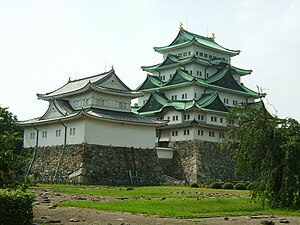Nagoya Castle: Difference between revisions
Miketheriley (talk | contribs) |
Miketheriley (talk | contribs) No edit summary |
||
| Line 2: | Line 2: | ||
[[Image:Nagoya Castle 01.jpg|thumb|300px|Nagoya Castle]] |
[[Image:Nagoya Castle 01.jpg|thumb|300px|Nagoya Castle]] |
||
{{nihongo|'''Nagoya Castle'''|名古屋城|Nagoya-jō}} is located in [[Nagoya]] [[Aichi prefecture|Aichi]], [[Japan]]. |
{{nihongo|'''Nagoya Castle'''|名古屋城|Nagoya-jō}} is located in [[Nagoya]] [[Aichi prefecture|Aichi]], [[Japan]]. |
||
[[Imagawa Ujichika]] built the original castle around [[1525]]. [[Oda Nobuhide]] took it from [[Imagawa Ujitoyo]] in [[1532]], but later abandoned it. |
|||
| ⚫ | |||
In [[1610]], [[Tokugawa Ieyasu]] ordered the various daimyo to help with the building of a new castle on the site. This new castle was to be the new capital of the existing [[Owari province]] and many of the materials used were sourced from the smaller [[Kiyosu Castle]] in the existing provincial capital of Kiyosu. Nagoya castle's construction was completed in [[1612]]. |
|||
During the [[Edo period]], Nagoya castle was the centre of one of the most important castle towns in Japan and the most important stop along the [[Tokaido]] road that linked the two capitals of [[Kyoto]] and [[Edo]]. |
|||
| ⚫ | |||
On top of the castle are two golden imaginary tiger-headed fishs , called ''kinshachi'' (金鯱 ''kin no shachihōko''); this motif is used as a talisman for fire prevention. They are said to be a symbol of the feudal lord's authority. Both ''kinshachi'' were temporarily lowered from atop the castle and displayed on the castle grounds, and briefly at the site of the [[Expo 2005]] from March 19th until June 19th of 2005, and were restored to the castle on July 9th the same year. As preparation for the World Expo plaques with English were added to most displays as well as a 3D movie showing the paintings in Hommaru Palace. |
On top of the castle are two golden imaginary tiger-headed fishs , called ''kinshachi'' (金鯱 ''kin no shachihōko''); this motif is used as a talisman for fire prevention. They are said to be a symbol of the feudal lord's authority. Both ''kinshachi'' were temporarily lowered from atop the castle and displayed on the castle grounds, and briefly at the site of the [[Expo 2005]] from March 19th until June 19th of 2005, and were restored to the castle on July 9th the same year. As preparation for the World Expo plaques with English were added to most displays as well as a 3D movie showing the paintings in Hommaru Palace. |
||
Revision as of 09:43, 24 April 2007
In Hizen Province, a castle also named Nagoya (名護屋城 (Nagoya-jō)), see Nagoya Castle (Hizen Province).

Nagoya Castle (名古屋城, Nagoya-jō) is located in Nagoya Aichi, Japan.
Imagawa Ujichika built the original castle around 1525. Oda Nobuhide took it from Imagawa Ujitoyo in 1532, but later abandoned it.
In 1610, Tokugawa Ieyasu ordered the various daimyo to help with the building of a new castle on the site. This new castle was to be the new capital of the existing Owari province and many of the materials used were sourced from the smaller Kiyosu Castle in the existing provincial capital of Kiyosu. Nagoya castle's construction was completed in 1612.
During the Edo period, Nagoya castle was the centre of one of the most important castle towns in Japan and the most important stop along the Tokaido road that linked the two capitals of Kyoto and Edo.
Until the Meiji Era, the castle was the home of the Owari clan of the Tokugawa family.
On top of the castle are two golden imaginary tiger-headed fishs , called kinshachi (金鯱 kin no shachihōko); this motif is used as a talisman for fire prevention. They are said to be a symbol of the feudal lord's authority. Both kinshachi were temporarily lowered from atop the castle and displayed on the castle grounds, and briefly at the site of the Expo 2005 from March 19th until June 19th of 2005, and were restored to the castle on July 9th the same year. As preparation for the World Expo plaques with English were added to most displays as well as a 3D movie showing the paintings in Hommaru Palace.

During World War II, The castle was burnt down on May 14, 1945 by the air raid of the United States, and most of its artifacts were destroyed; many of the paintings inside, however, survived and have been preserved to this day. The rebuilding of the castle finished in 1959. Today the castle is a modern concrete building with airconditioning and elevators. In addition, there are plans to reconstruct the Hommaru Palace (本丸御殿 Hommaru Goten), which was also lost to fire during the war. Many of the paintings from this palace were also rescued, and replicas of these paintings will be placed in their appropriate locations within the restored palace. Until then, many of the objects formerly in the Hommaru as well as replicas of sliding shoji doors and the reconstructed Nō stage can be seen in the Tokugawa Art Museum, Nagoya.
